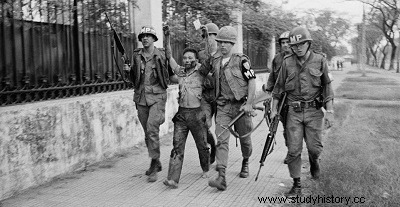
One of the very first attacks, and one of the most small, carried out by a suicide squad of only 15 Vietcong sappers, was to take on an importance out of proportion to its size. It hit the American embassy in Saigon, a few blocks from the presidential palace and downtown hotels where American reporters and television cameramen were housed.
The embassy was a new building, reinforced, surrounded by a sturdy wall, perhaps the only embassy in the world to have a helicopter pad on the roof.
On January 31, before dawn, sappers in civilian clothes blew a hole in the wall. Two military police guards killed the first two Vietcong to enter embassy territory, but they themselves were killed after an exchange of gunfire. Two military policemen, arriving by jeep to the rescue, succumbed in turn, just as the American Marine climbed to the top of a nearby building to fire into the crowd. Another military policeman closed the heavy doors of the chancery so that no Vietcong could enter. building. Taken under fire from a helicopter and, shortly after daybreak, by a platoon of American airborne troops helicoptered to the roof of the Chancery, all the Vietcong were shot down. The attack lasted about six hours.
From a strictly military point of view, it did not matter whether the Vietcong sappers had penetrated the chancellery or not.
For many journalists and, therefore, for many people in the United States, this attack appeared as confirmation that Westmoreland and President Johnson had been spreading lies. If the United States could not ensure the protection of its own embassy, how could the war have reached a point "where the end is beginning to be in sight"? The fact that no solid line of fortified trenches surrounded South Vietnamese cities (an unrealistic measure) and that even a weakened enemy was capable of launching small suicide attacks against just about any installation was overlooked in the sensational press and television reports. The long-smoldering antagonism between journalists and officials had suddenly flared up!
Elsewhere in Saigon, five small groups of Vietcong sappers attacked on their side. One of them, made up of Vietcong in ARVN uniforms, stormed the presidential palace but was repulsed. Security forces from the battalion occupied a cemetery and a racetrack:it took the intervention of South Vietnamese troops to dislodge them. More serious were the operations carried out against Tan Son Nhut airfield and against the headquarters of the ARVN General Staff, on the outskirts of the capital.
However, they too were eventually rejected. On January 31, President Thieu decreed the application of martial law; On
February 5, Saigon was clear of all enemies.
As reports began to trickle in from other parts of South Vietnam, it became apparent that the Communists had launched a general offensive throughout the country; they threw into battle some 84,000 men, mostly Vietcong, except in the northern provinces where North Vietnamese regulars predominated. The Communists attacked, with infantry or mortars and rockets, 36 of the country's 44 provincial capitals, 5 or
6 autonomous cities, 64 of the 242 district capitals and 50 hamlets. In 13 towns and cities they entered in force but were dislodged in two or three days. The fighting lasted only in Saigon and Huê. The latter was entirely occupied by the Vietcong and the North Vietnamese regular soldiers, with the exception of the headquarters of the 3rd division of the ARVN installed inside the citadel and the complex housing the advisers of the US Army. . The allies hesitated at first to use artillery and air force for fear of damaging historic buildings. It took twenty-five days for an ARVN division, supported by three battalions of the US Marine Corps, to liberate the city.
